In June 2003 and July 2004, I received some emails asking for help with the history of St. George, Whitehall and in particular, The Old Georgians. These I put on the Help Wanted pages. On the last day of 2013 a lady named Caroline contacted me with some information that led to the creation of this page.
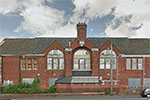
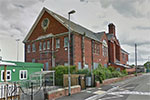
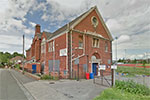
Old Georgians Sports and Social Club
The above photos were taken from Google Maps.
Retrieved 1st January, 2013, but the photos were taken in June 2012.
Caroline wrote that The building was called the Bruce Cole pavilion and concert hall, Messrs H. J. Packer and Co. had the plans drawn up and building erected for the benefit of the Packers Chocolate Factory employees. During the First World War the club first served to house Belgian Refugees and in 1916 as a Military Hospital. I am trying to find out who built the main building as I know Cowlings built the extension in 1916 but they do not have any more information. We know the city council took over the running off the club in the 1930s. Caroline wants to see the building repaired and listed as an historic building.
A letter of intent to build the pavilion in Johnson's Lane was deposited with Bristol City Engineer and Surveyor's Department on 16th January, 1912 by Walter J. Paul and Sons of 31 Nicholas Street, Bristol. The estimated cost of the building at the time was £5,000.
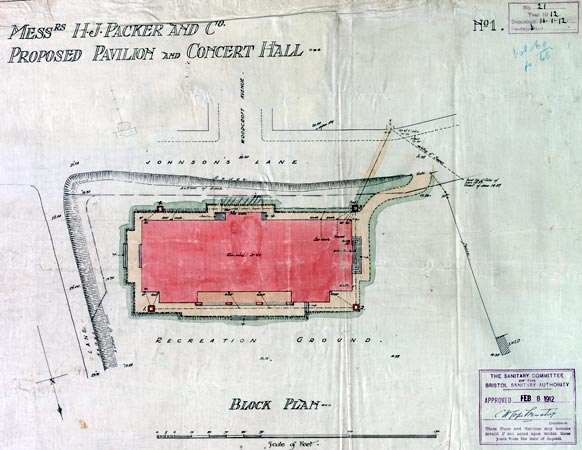
Plans for the pavilion and concert hall
These were approved on 8th February, 1912
Bristol has a long and distinguished history concerning chocolate. Joseph Fry, a Quaker, of Fry and Sons set up his factory in 1728 in Newgate Street, Bristol. The factory was moved to Union Street in 1777 and produced the first chocolate bar as we know it in 1847. In April 2000, 2 1lb tins of Pure Concentrated Cocoa and 2 of Malted Cocoa, made in this factory were auctioned at Christie's. The reason these tins are special is that they were recovered from Captain Robert Scott's doomed Antarctic expedition. They were given to Scott in 1910 and 11 tins were recovered from the camp in 1955. The tins were returned to Fry's, which by then had moved to Keynsham.
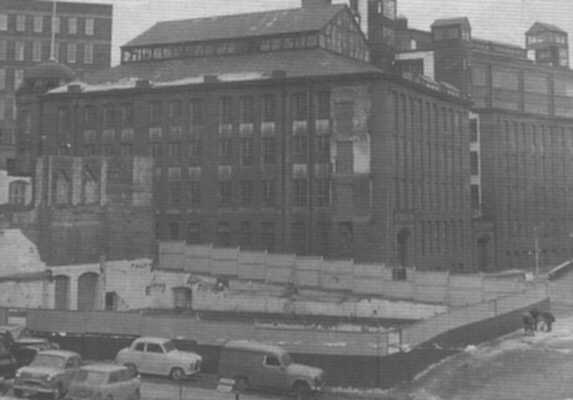
Fry's Chocolate Factory, Union Street, Bristol
H. J. Packer was an employee of Fry's and in 1881 left to set up his own chocolate factory at 46 Armoury Square, Easton with three employees each earning 2/6d a week. In 1883, the company moved to new, larger premises in St. Pauls St. and in 1884, Bruce Cole, whom the pavilion and concert hall was named aftter, paid £950 in his take-over of the company. The company moved again in 1901 to even larger premises in Cooperation Road, Greenbank. The company had a series of owners from Bonds to Famous Names and finally to Elizabeth Shaw which closed in 2006.
During the First World War the club first served to house Belgian refugees and in 1916 as a Military Hospital when it was called the Bruce Cole Auxiliary Hospital. First class cricket had been played there since 1922 with the first major match being between Gloucestershire and Sussex. In 1926, a bowling green was opened on the site which already also hosted football and tennis matches. The company had mixed fortunes and in 1935 had to sell the pavillion, sports fields and company houses to the local council.
The area is currently in danger of being leased and campaigns such as Packers Field have been started by local residents to keep the area free.
In December 2020, I got an interesting email from Vernon Ford about Packers Field and Pavilion. Vernon wrote:
I was a boy at St George Grammar School 1953-1961. Packer’s Field and the Pavilion were used throughout that period by the school for sports and teaching. Subjects were Woodwork, Metalwork and Geometrical & Machine Drawing (one of my O-levels) for boys, Cookery & Needlework for girls and if memory serves me correctly art for boys & girls. There were changing rooms and showers for outdoor sports. The first floor had a stage at one end, it was occasionally used by the school as a theatre and for exams. I don’t know when the school started or finished using the premises.
As far as I know St George Grammar School was the only council grammar school in Bristol to teach practical subjects and I’m fairly sure that was unusual nationally. In addition to council secondary modern schools, Bristol during my time also had a council Technical School for boys and a council Commercial School for girls. These were for those who had gone to secondary modern school but who showed significant ability in those directions. My memory is that entry to the Technical & Commercial Schools was at age 13, I’ve no idea how they were selected.
Vernon has been looking through Old Maps Co UK and came up with some information about how the workers at Packers got to Packers field over the railway that separated the two.
There appears to have been a footpath from Johnson’s Road via what are now Bruce Road, Carlyle Road, Thurlow Road and Greenbank View to Fishponds Road. On a map of 1882 the path appears to go under the railway, by 1904 a map shows a footbridge.
Sources
A History Of Chocolate
Cadbury Notes: J. S. Fry & Sons
Clifton Rugby Football Club History
Forlorn Britain: Elizabeth Shaw Chocolate Factory, Bristol (Internet Archive)
History of Bristol Greenbank Bowling Club (Internet Archive)
Living Easton: Living Easton Timesigns Trail (Internet Archive)
Living Easton: Packer's to LEAF (Internet Archive)
Packers Chocolates (Bristol)
Packer's Field
Scarletfinders: UK Home Hospitals 1917: Southern Command
Wikipedia: Greenbank Cricket Ground
Wikipedia: J. S. Fry and Sons
This page created January 1, 2013; last modified January 25, 2022




